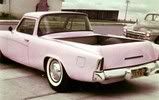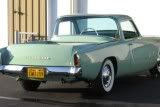I just completed installing a new brake system on my 1950 Champion. I replaced the OE M/C with one for a 1976 Corvette. I have adjusted the brake shoes out to the drums as directed (adjust one shoe till drum won't turn, then back off till it will, barely by hand and then do the same for the other shoe). I have done this for all 4 wheels so that at this point I can turn the drums (barely) by hand.
I installed the 10# resisters (can't remember what they are called) in both lines as required with the turner system.
I have bled each wheel so that bubbles are no longer showing up in the bleeding jar and I have a really firm pedal. However, I expected to feel resistance soon after passing the original 1/4" "play" in the pedal. Hope this makes sense. My question is, how many inches should be between the front of the foot pad on the pedal and the floorboard?
Sincerely,
Jimmie
Orleans, Indiana

1950 CHAMPION -ORANGE COUNTY, INDIANA
I'VE SAVED SO MUCH DAYLIGHT THAT THERE'S NO DARK TO SLEEP IN ANYMORE!
I installed the 10# resisters (can't remember what they are called) in both lines as required with the turner system.
I have bled each wheel so that bubbles are no longer showing up in the bleeding jar and I have a really firm pedal. However, I expected to feel resistance soon after passing the original 1/4" "play" in the pedal. Hope this makes sense. My question is, how many inches should be between the front of the foot pad on the pedal and the floorboard?

Sincerely,
Jimmie
Orleans, Indiana

1950 CHAMPION -ORANGE COUNTY, INDIANA
I'VE SAVED SO MUCH DAYLIGHT THAT THERE'S NO DARK TO SLEEP IN ANYMORE!


 [IMG]
[IMG] [/IMG]
[/IMG] , brakes on all American cars at this time were also not that great.
, brakes on all American cars at this time were also not that great.
Comment